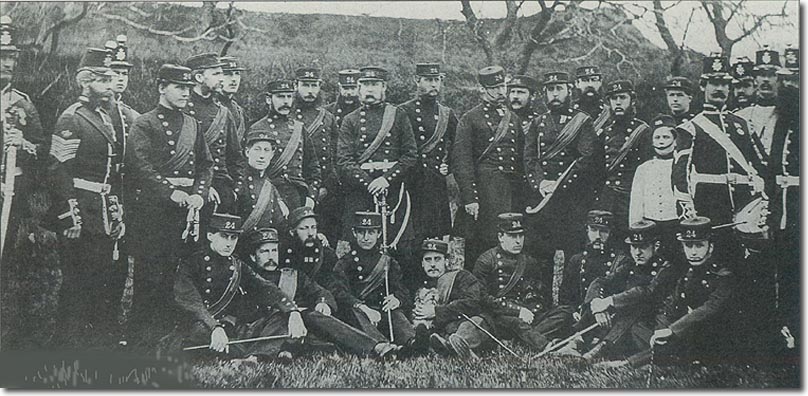|
|

 |
|
This photo shows officers of the 1st Battalion 24th in 1862. We know it is not the 2nd Battalion which was formed in 1858 and served in Mauritius from 1860 to 1865. The background of this photo does not look like Mauritius. The 1st Battalion had returned, in 1861, from a 16 year posting in India. They were at first in Gosport and Portsea, then in Sep 1862 marched to Aldershot where they stayed until April 1864. The battalion was commanded by Colonel Wodehouse who may be the central figure with a white belt resting his hands on his sword. The battalion had a strength of 28 officers, 44 sergeants, 39 Corporals, 20 drummers and 720 privates.
The officers are all dressed in blue frock coats. These are double-breasted with gilt buttons and are not adorned with black mohair like the later versions. They have slash cuffs all in the same material as the coat but with three buttons. The crimson silk sash on the left shoulder is held in place by a crimson silk cord which is on the left shoulder only. The field officers have their rank embroidered onto their collars, a star for a major and a crown for a lieut-colonel. All the other officers have no rank distinctions. The peaked forage cap is blue with a black silk oak-leaf pattern cap-band and 24 in gold embroidery on the front. Two of the officers have chin-straps. On the left of the photo is the Regimental Sergeant-Major with four gold chevrons on his sleeve and an embroidered crown above. He has a tunic with slashed cuffs which have gold lace. In 1855 the coatee was put aside in favour of the skirted tunic. The first double-breasted version was not successful so it was changed in March 1856 to the basic style that remained for many years. All the other ranks are in dress uniform with the shako that was worn from 1861-69. This type of shako had a thin leather chinstrap but no-one is wearing it in this photo. On the right of the photo is a drummer in red tunic with regimental pattern lace around the collar, sleeve and shoulder wings. The lace had red diagonal lines along its length. In 1866 the universal pattern was adopted with red crowns. Behind him are bandsmen (and band boy) in white shell jacket or white tunic. Just visible on the extreme right is a bearded pioneer. |
Armed Forces | Art and Culture | Articles | Biographies | Colonies | Discussion | Glossary | Home | Library | Links | Map Room | Sources and Media | Science and Technology | Search | Student Zone | Timelines | TV & Film | Wargames
